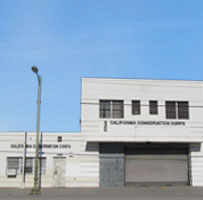Behind the Fence
Teachers tell us why they love teaching at John Adams Middle School.
Relics of the post-WWII era still stand tall along Main Street - air raid sirens. Although they were originally installed to alert Angelinos of an impending air strike, they have been configured to serve as part of the statewide Emergency Alert System. During the 1992 Los Angeles riots, certain public services were stretched beyond their limits and while some eventually expanded, some were discontinued. Listen to find out how the city responds to crisis, whether it be natural disasters or urban unrest.
LACMA has a special library program where representatives go to libraries throughout Los Angeles and teach art to children and their families for free. At the Junipero Serra Library, children are taught art techniques such as drawing, painting and sculpting. However, the purpose of the program is not just to teach kids art skills; it's also about exposing the kids to culture and getting them to interact with one another.
PVJOBS on Main St. provides training and job placement for careers in construction for at-risk Angelenos. Applicants must meet certain requirements such as a history of substance abuse and have been referred from a partnered advocacy group.
By Laura Cueva
John Adams Middle School is anything but what you'd expect.
Located in South Central Los Angeles, the school is bordered by chain link fences eight feet high. The sixth graders on the P.E. field kick around a deflated soccer ball after the sixth period bell rings. The smell of a stink bomb is slowly making its way through the school's corridors, and an administrator can be overheard saying "They've been going off all day."
But, despite the looks of it, John Adams isn't a terrible school. In fact, it's quickly becoming one of the best middle schools in the state.
"The school is going up," said assistant principal Jorge Calderon. "Last year, we had the highest improvement on California's state tests. We grew by 44 points; that means the school's getting better."
And indeed it is. Adams is now only two points away from reaching California's academic performance average of 700 and that much closer to the state's target of 800. Two years ago, it was 46 points away from the 700 performance average.
Though it may not sound very substantial, the school's expected growth from spring 2009 to spring 2010 was a mere seven points.
"I can see a difference in the quality of the education," said Maria Lopez, parent of a seventh grader and herself an Adams alum. "I received a good education, but my son is in the school's magnet program and I always stop and think to myself, 'Wow, I didn't learn this when I was his age.'"
Built in 1923, Adams is one of the oldest middle schools in California. Once an overcrowded urban school that packed 2,400 students on a campus built for 1,600 Calderon boasts that the largest class size now is only 24 students and the total number of students enrolled is exactly 1,603.
"The administration is supportive [of the growth]," said Anna Melkumyan, a math and science teacher. "Everybody, they all put everything they can, whatever necessary, into making sure students do well."
Despite the school's progression, ensuring students do well is still difficult, given cultural and language barriers. Ninety-nine to 100 percent of the student body is Hispanic, according to administrators, and students' median household income is just over $17,500. Many students are immigrants, or the children of immigrants.
Understanding the children's cultural background is integral to their success in school, said Anais Mercado, parent of an Adams sixth grader.
"I can talk to the people," Mercado said. "When I have questions, the administrators speak Spanish and that's really important."
A majority of the faculty speak Spanish as well, but even those who don't understand the importance of being able to communicate with students, no matter which language they speak.
"They are teaching me Spanish now," Melkumyan laughed. "When I go back to Russia, I can tell all my friends and family that I finally speak Spanish."
Melkumyan incorporates language into a special type of arithmetic she calls Singapore Math, a technique that helps those who don't fully understand English understand it better as they learn, mimicking the techniques used in high performing countries like Singapore.
"It's more pictorial, visual representations of the problems," Melkumyan said. "And, it's all about word problems. It helps them build up vocabulary, words like 'twice,' 'double,' 'out of,' 'percentage.' They're all part of the problems."
Ultimately, students recognize the commitment Adams puts forward toward their education.
"I do, I like it here," said Jose Ruiz, a sixth grader. "I like the fun classes more, like art and P.E., but I've been doing well in my math class so I keep doing it."
Encouraging student engagement is tough, Melkumyan said, so she focuses on interaction and positive reinforcement, which she says instills confidence in her students.
"My [math] teacher puts my work up on the wall so that's cool," Ruiz said. "My friends are jealous."




